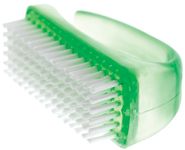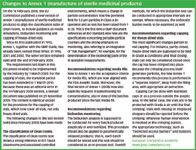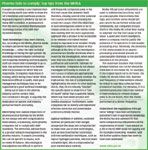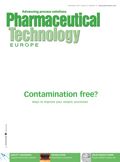Aseptic challenges: the experts' view
Pharmaceutical Technology Europe
What have been the key innovations that have shaped current aseptic practices and techniques?
What have been the key innovations that have shaped current aseptic practices and techniques?
Henderson: The number one consideration for aseptic practices and technique is risk minimization. Since the mid-1990s, the development of isolators and restricted access barrier systems (RABS) has substantially changed how operators interact with sterile drug product and their associated technique. A physical barrier between the operator and the critical zone of the isolator controlled at positive pressure with HEPAfiltered air creates a high level of contamination control. Most interactions through isolators and RABS are done through glove ports, which again limits the risk to the associated product. In addition, the ability to biodecontaminate the critical zone and clean-in-place/steam-in-place (CIP/SIP) contact parts has led to less operator involvement and further reduces risk. Magriotis: Isolation technology is replacing conventional clean room aseptic technology within the most developed areas of the pharmaceutical industry. The technology's major benefit is the higher aseptic conditions that can be achieved and maintained during manufacturing. Isolators provide a complete barrier between product and operators, who are the highest source of contamination in aseptic processing. Isolators also guarantee a higher sterility assurance level after decontamination compared with conventional clean room technology (usually 6 Log contaminants reduction versus 3 Log reduction). This is achieved by means of vaporized hydrogen peroxide.

Jerold Martin
Furthermore, in 2008, the European Commission issued a GMP document for sterile drugs preparation stating that the sealing of sterile vials with aluminium caps must happen under Grade A laminar air flow. Consequently, the most innovative machinery manufacturers have reviewed the design of their aluminium capping machines; the latest models incorporate features that make them suitable to work under laminar air flow and that minimize particle generation to maintain the required level of air cleanliness. Martin: Key innovations have been singleuse systems (processscale filter capsules, tubing, biocontainers, etc.), which are presterilized (by gamma irradiation) and preassembled to eliminate aseptic connections and cleaning. These systems have been further enabled by the introduction of sterile connectors. Use of singleuse systems and sterile connectors reduces risk of both microbial contamination and chemical contamination from lottolot or producttoproduct carryover or from cleaning agent residues. Because they are closed systems, they can even enable sterile processing to be done outside of isolators or Class A environments.

(George Doyle/Getty Images)
Another key innovation is the development of new high capacity 0.1µm-rated filters with high mycoplasma removal capability. These are used for sterilizing filtration of soy peptonebased bacterial culture media used in aseptic filling line validation to ensure the absence of mycoplasma, such as Acholeplasma laidlawii, in the sterile media fill validation of the aseptic filling line.

David Henderson Jr
What are the key challenges to successfully implementing aseptic techniques and technologies?
Henderson: Some major key challenges with implementing appropriate aseptic techniques and current technologies are centred around clean room design. Retrofitting a conventional clean room with isolator or RABS technology can be difficult because it will often change the air dynamics and may require changes to the existing heating, ventilation and air conditioning (HVAC) systems. Changes in HVAC are extremely expensive, which often deter companies from installing these types of technologies into existing clean rooms. Another key challenge, is implementing technologies and practices that meet multiple regulatory expectations. Companies who market and sell products globally must meet the compliance expectations of many regulatory authorities. Magriotis: Training of operators. Only highly skilled and disciplined operators can ensure the correct implementation of aseptic techniques. Several companies can't (or don't want to) implement aseptic techniques because of inadequate company culture or the inability to establish suitable standard operating procedures (SOPs). These factors sometimes represent real challenges for companies Martin: The primary issue in implementing singleuse systems to replace cleanable stainless steel equipment (filter housings, piping, tanks, filling lines) is the development of extractables data from the singleuse plastic equipment to validate that they do not contribute chemical contaminants to the final product. The Bio-Process Systems Alliance (singleuse trade association) has developed recommendations for single-use equipment suppliers to develop generic extractables data that can be referenced by end users implementing the systems. Suppliers such as Pall have developed libraries of extractables data that can enable users to conduct risk assessments without having to initiate new studies.

Nicola Magriotis
What future innovations do you predict in aseptic techniques and technologies during the next 5 years?
Henderson: In the next 5 years, I believe there will be additional consideration for reducing manual operator interaction during the manufacturing process and making the process more automated. Manual aseptic operations provide a number of uncertainties and risks. Currently, a popular topic for regulatory agencies is risk management of aseptic operations. I believe there will be a large demand to make the process fully automated and thus reduce the associated risk. Magriotis: The use of sterile ready-to-fill vials (as it has already taken place with prefillable syringes). Also, I believe we will see an increased use of plastic, such as cycloolefin copolymer, containers as an alternative to glass. Martin: Rapid microbiology methods will increasingly be employed for bioburden analysis and, in some cases, sterility testing. In addition, automation (robotics) will minimize operator interventions to further reduce the incidence of false positives.

Changes to Annex 1 (manufacture of sterile medicinal products)

Pharma fails to comply: top tips from the MHRA
David Henderson Jr Manager, Sterile Filling, Ben Venue Laboratories, Inc.
Nicola Magriotis Macofar Product Line Manager, Romaco Group
Jerold Martin Senior Vice President, Scientific Affairs, Pall Life Sciences

Drug Solutions Podcast: A Closer Look at mRNA in Oncology and Vaccines
April 30th 2024In this episode fo the Drug Solutions Podcast, etherna’s vice-president of Technology and Innovation, Stefaan De Koker, discusses the merits and challenges of using mRNA as the foundation for therapeutics in oncology as well as for vaccines.